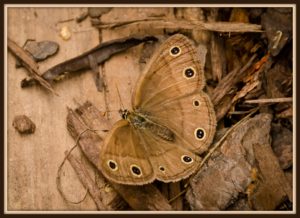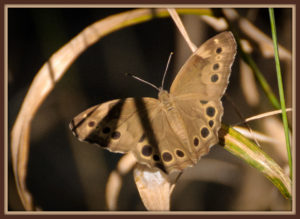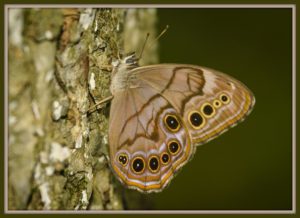Monday Satyrs
Monday Satyrs
March 6, 2017
Double-click on any image to view it full size. Click the back-button to return to your place on this page.
Greetings!
Thank you for all the stories you sent me regarding the Pileated woodpeckers featured in last week’s essay. I would be pleasantly surprised if this week’s subjects prompted such vivid memories!
The Satyrs (more technically Satyridae) are a family of small to medium size brownish butterflies that are typically seen fluttering through partially shaded woods. There are three species to be found here in Northern Virginia. They are not usually seen on flowers, because they tend to feed on tree sap and plant juices rather than nectar.
The largest (about the same size as a Red Admiral), and from my experience the most commonly seen, is the Common Wood Nymph (Cercyonis pegala). (Is anyone else puzzled that a nymph would be included with the satyrs?) Picture #1 shows one resting – as they typically do – wit the fore-wings tucked inside the hind-wings. In this pose, viewed against the bark of tree limbs they frequently rest on, their camouflage is very effective.
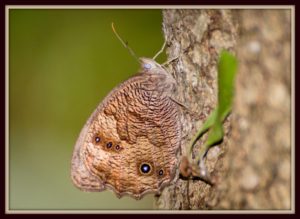
However, if a predator should threaten, they will suddenly expose the fore-wings, revealing a large yellow area, and one or more large eyespots (picture 2).

This will either scare the predator away, or at least startle it for long enough to allow the butterfly to escape to a safer spot. Picture #3 shows the upper surface of the wings, which also carry the yellow patch and eyespots. At least to this human, it is usually the fluttering yellow patch that gives away the presence of these butterflies.
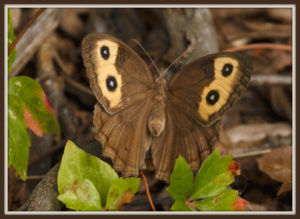
Somewhat smaller is the Little Wood Satyr (Megisto cymela). This butterfly (Pictures 4 & 5) lacks the prominent yellow patch and large eyespots, instead having two spots on each surface of each wing, although the spots on the lower surface often show additional, fainter, “ghost” spots.
The third species, the Appalachian Brown (Satryodes appalachia) (Pictures 6 & 7) is the same size as the Little Wood Satyr, but has more numerous spots. I am reasonably confident with my identification, but some sources give the binomial name as Lethe appalachia. Furthermore, there is another species that is visually almost identical, the Northern Eyed Brown – Satyrodes (or Lethe) eurydice. I am opting in favor of S. appalachia on mainly geographical grounds.
The small eyespots on the Satyrs are believed to serve the survival of the butterfly by distracting predators, who are believed to mistake the eyespots for the real eyes, and consequently attack the wrong end of the butterfly.
Most butterflies carefully lay their eggs on the exact kind of plants that the larvae will feed on, and the Satyrs will sometimes follow that behavior, but at other times will simply launch their eggs in mid-flight into generally promising-looking habitats, hoping that the larvae, when they hatch, will be able to find the right kind of plant upon which to feed!
Have a great week!

